Tomb Raider: Angel of Darkness
Adventurous return or the final insult?
It's been delayed three times, slapped with a succession of unusually critical previews, and subsequently praised by less than convincing reviews. You could say it's been a rocky road in the build up to the release of the latest Lara Croft adventure.
Even the Official PlayStation 2 Magazine only gave it 8, and struggled through a long list of flaws before having to painfully justify its score, and as we scribe, the first 'proper' reviews have started to filter through and it seems that years of hype and promises have come to nothing.
"We don't care if it's finished, just get it out the bloody door before the City lynches us!"
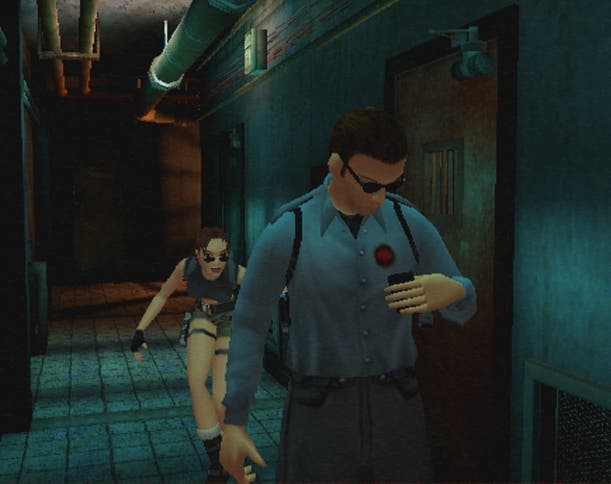
And to add insult to injury, the Yanks got it before us, as under pressure Eidos scrambled frantically to get the game shipped in time for its third quarter. Bizarrely, the City wasn't even told that the game had slipped again, and even the normally in-the-loop retail community hadn't got the faintest clue as to when the game was going to be shipped. "Definitely before the 30th", an Eidos spokesman assured us, although that looks increasingly unlikely. What an almighty cock up.
As much as we try to remain impartial to the weight of outside opinion, we must admit we were more than a little nervous as we finally took possession of Tomb Raider 6. But at the same time, having thoroughly enjoyed the majority of the series we couldn't quite believe that over three years of development would result in failure. We had faith, even if the ropey demos at E3 and last year's PlayStation Experience suggested we should prepare for the worst. Surely the naysayers were just the unbelievers that didn't have the patience in the first place?
This was supposed to be the reinvention of the series; where gamers got to see a 'darker' side of Lara, "a new harder edge that has arisen from her inner demons". This was Core's big chance to give the previous annual cash cow series a break and return with fresh ideas, some groundbreaking technology and renewed vigour to revitalise arguably the most important British gaming franchise ever.
The bitch is back
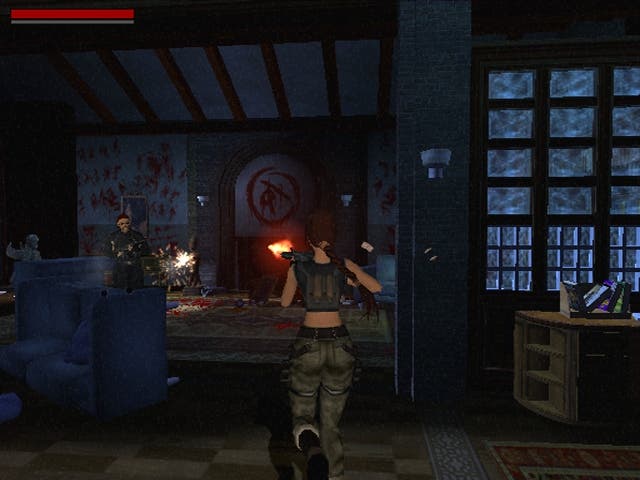
The storyline and scripting is certainly a cut above most gaming fodder, and an area Core has paid an enormous amount of attention to. The game kicks off in Paris with Lara in conversation with her old mentor Werner Von Croy, who has been asked by a 'sinister' client Eckhardt to help him track down an old 14th Century painting. Having suffered a past betrayal Lara is understandably a little pissed off, and soon an argument ensues which coincides with the brutal shooting of Von Croy.
Framed for his murder, the game follows Lara's desperate escape from the law, and her subsequent pursuit of the shady Eckhardt character and his plot to awaken the long dead Nephilim race. It probably sounds like typical gaming fodder, but the scenes are lavish, interesting and don't outstay their welcome, unlike many action adventures with illusions of cinematic grandeur. During the Paris levels, AOD even reminded us of Revolution's much cherished Broken Sword, which can't be a bad thing.
As good as the plot undoubtedly is, the voice actors do their bit to undermine its effectiveness. Although Lara's part is played admirably, the bit part players with their dreadful cod-French accents are laughable in the extreme. Surely Core's budget could've stretched to employing some decent voice actors after all these years. Apparently not. Vice City vs. Angel Of Darkness: compare and contrast the voices. The music, however, is excellently atmospheric throughout, and easily the best yet in the series. Hats off to the audio guys for bothering with surround sound too.
Much the same
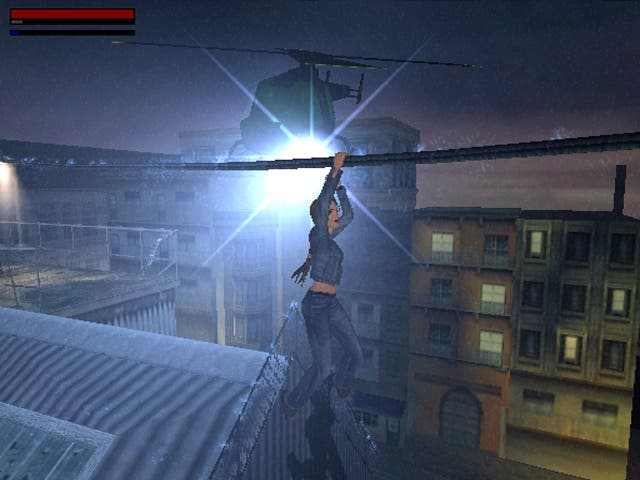
Unlike the other games in the series, Angel Of Darkness does at least try and introduce the controls to the player. The first few sections amount to nothing more than a training session, but for many this lead-you-by-the-hand approach will come as a welcome introduction. For anyone even vaguely familiar with previous Tomb Raiders, the controls feel much the same, albeit with a few context sensitive tweaks in the name of making the game more accessible. Apparently the controls were a massive bone of contention internally, and have been the chief cause of the delay - we were hoping this was for good reason.
The main change is the addition of a fairly unnecessary stealth manoeuvre, which puts Lara in a semi-crouch pose, allowing her to sidle up against walls Solid Snake-style and peek around corners, as well as perform a deadly neck breaker attack behind unwary enemy. The usual array of moves remain, including running/sideways/backward jumps, grab, run, walk, push, pull and crawl, while the auto-targeting attack makes shooting relatively easy.
Unfortunately any vague notions of having fun with this long-awaited title quickly disappear once you realise how truly heinous the control system really is. Part of the blame has to be squared firmly at the hopeless camera system, which is continually fighting against you like an overzealous mother yanking her sprightly young toddler back into line.
Core knows best
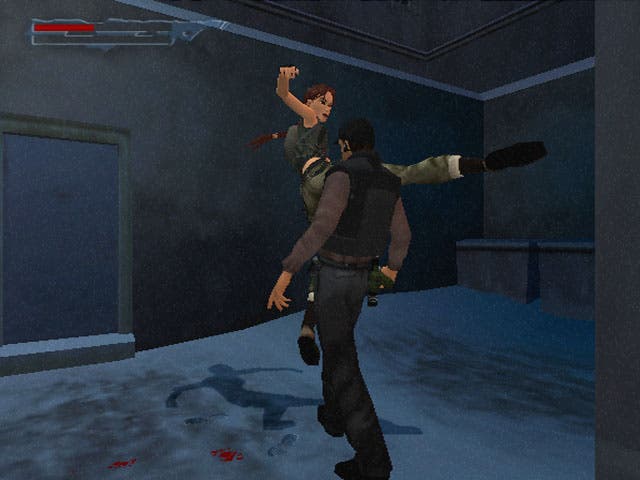
Although you're allowed a degree of 'free' movement with the right analogue stick, for the most part Core's cameraman thinks it knows best and continually tries to show off with 'dynamic' cuts to dramatic angles, which has the effect of confusing the hell out of you as you'll probably now be holding the opposite direction that you were when you started.
This, in itself, wouldn't be an issue if you could actually position Lara with any accuracy. Rather than do the decent thing and attempt to match the fluidity and precision of, say, Splinter Cell, Core has made Lara even more infuriatingly tricky to position than ever, and you'll be constantly attempting to make minor adjustments, only to overshoot thanks to the alarmingly unresponsive controls. You are given the safety net of the walk mode, which stops our heroine from falling to her doom, but accidentally push up against a low railing and she'll happily hop over it to her death no matter what the obvious consequences are.
In some areas this context sensitive guesswork is quite useful, and enables you to perform certain mundane tasks like mounting and dismounting ladders and drainpipes with ease. But given that you still have to perform actions on a multitude of other objects, would it have really been a great hardship for the player to decide when to carry out the move? In doing so, you're constantly snagged into performing actions that you don't want to, and it quickly becomes extremely irritating, and even many hours into the game you'll still be tipped up by it.
I'm too weak to go on reviewing
Even the puzzle system remains largely unchanged. It's still a case of endless trial and error, object collection, switch pulling, box pushing and jump after jump after jump. But one minor addition that will have you laughing out loud in exasperation is the "I'm not strong enough" complaint that Lara will utter, seemingly whenever you want to make real progress. In what has to be the most hopelessly contrived game mechanic of all time, you have to wander around looking for some random object to interact with, at which point Lara will utter "I feel stronger now", allowing you to trawl back to whatever obstacle Core has thrown up for you. As you go through, Lara will eventually be able to jump further, climb for longer and run faster; we were just wishing she'd gone on a training course beforehand. We resented being her virtual fitness instructor.
I feel stronger now
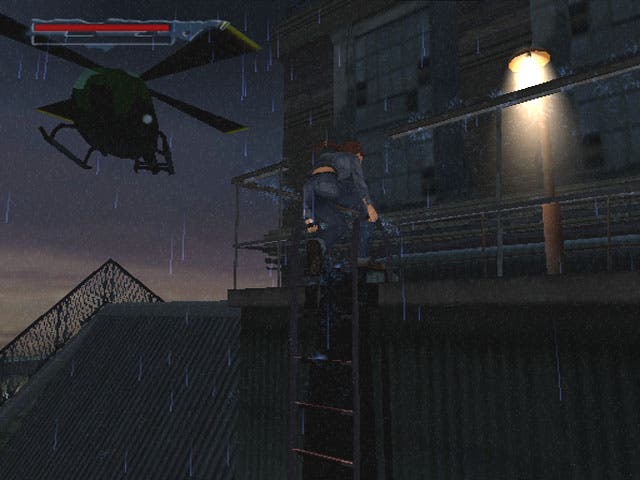
Despite suddenly becoming a couch potato, Lara's lithe yet voluptuous looks remain firmly intact. As you'd expect, the extra 4,500 polygons have been put to predictable use, with her still pert breasts now fully animated to a worryingly precise extent. You might think we're sad for even noticing this, but Core clearly wants its audience of drooling cock-choking males to know about it. Mammary mania aside, the 128-bit Tomb Raider has certainly benefited from Core's artistic flair, with almost every multi-tiered location crammed with detail and careful incidentals. Check out the fish tank or the stupendously impressive disco lights in the Louvre night club and you'll know what we mean. In other areas, however, the texturing is poor and lacks detail, shadows are cast into thin air, characters clip into the scenery, while the stylised character models look strangely at odds with their surroundings, Lara or her playable sidekick Kurt aside.
Such detail-packed environments come at a price, however, and Core's inelegant system of constantly reloading small chunks suggests the Derby-based team has had a far harder job adapting to the PS2's limitations than DMA or Naughty Dog, despite being one of the very first developers in the world to receive PS2 dev kits. It's disappointing to note that AOD bears the hallmark of 32-bit design and technology in nearly every respect, bar some occasionally outstanding visual prowess, and it's a great shame that Core has failed to keep pace with those it was once years ahead of. With the news that two more Tomb Raider titles are to emerge with this same engine, we can only dread to think just how dated Tomb Raider 8 will look next to all those Source-based games.
While we're on the subject of ageing tech, it's worth noting that the abandonment of checkpoints for a save anywhere system introduces a new world of pain - the lengthy saving and reloading of your progress. And worse still, the game doesn't even have the courtesy to offer an auto save once you've completed a level, meaning the inevitable swift death on the commencement of a new level will all-too-often result in you having to reload from the middle of the last one. No, we couldn't believe it either, and the repeated frustration of this happening turned us into saving maniacs.
Patient fools
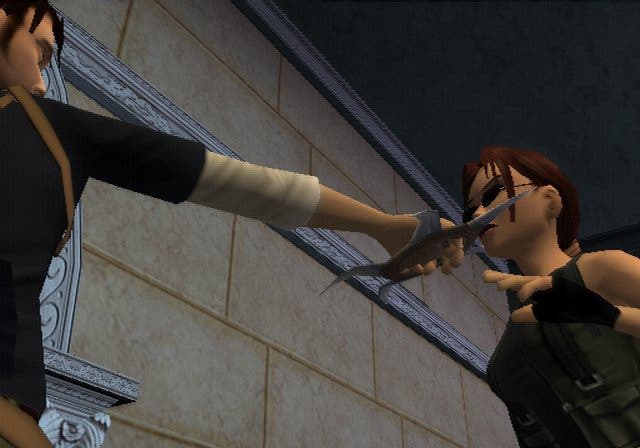
As with all the best Tomb Raider games, the experience hangs entirely on the quality of the level design. And to say that we were more frustrated with some of the old school stylings in Angel Of Darkness than with any previous Lara adventure spells out the depth of the flaws inherent in this game. Don't for one second presume we're running out of patience in our old age. No sir. We, in fact, spent about five hours on one level, desperately attempting not to be beaten by it, only to discover that Lara has magic insect Velcro hands that can apparently stick to certain predetermined ceilings that she can monkey swing across. And don't get us started on the Louvre Galleries debacle. While the game is only too happy to offer tips on the very first level, there are some mind bogglingly obscure or pedantic sections that could benefit from clearer signposting, (or some play testing, dare we suggest). We realise that frustrating trial and error has always been a key component in Tomb Raider games, but it seems even more pronounced in AOD, and are certainly more of an irritation as a result.
The real crowning glory of Core's mess up is the truly ridiculous AI. To say that it's virtually non existent is perhaps the understatement of the century. It makes other often criticised games, such as Metal Gear Solid, Halo, Splinter Cell and more recently, Brute Force seem like works of godlike genius by comparison. Enemies in AOD shamble around like blind Alzheimer sufferers, often failing to notice you when you've followed them around a room twice waving in their faces and farting profusely. But even if they do happen to spot you, the auto-targeting makes it so easy to cap them it removes any sense of challenge anyway. To compound the comedy, downed enemies flash and disappear, retro-style.
The unholy alliance
Anyone intending to buy AOD should go into it with their eyes wide open. You're going to get stuck, regularly, without remorse. And the main reason you'll get stuck is the terribly unresponsive controls' unholy alliance with the drunken camera that render the proliferation of tediously precise jump puzzles much more of a challenge than they should be. Core claims there's 50 hours of gameplay in AOD, and it's probably right - it takes five times as long to get anything done.
As a died in the wool Lara fan, it pains me to see the painful decline of a once great franchise. It would be perhaps harsh to dismiss AOD as a disaster, because real patience and persistence will reap a degree of rewards and satisfaction. The sad fact is, though, those who care passionately about the brand will be gutted that Core has failed to progress one of the most exciting and compelling 32-bit franchises. The real tragedy is that in gameplay terms it's a marked backward step for Tomb Raider and the damage this half baked, unfinished travesty of a game will do to the brand equity is incalculable. Sad to say it, AOD is indeed DOA for anyone but the most devoted Laraphile.


